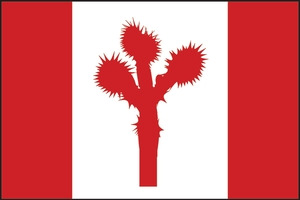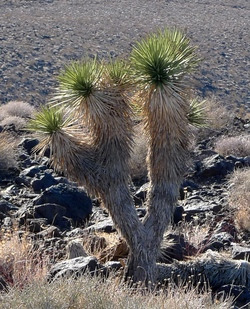Pololu Blog » Engage Your Brain »
What's in a name?
At the risk of sounding like I’m telling you to eat your vegetables, I’m going to zoom out one more step from the last post about units and talk even more generally about the importance of names. Whatever you think of Juliet’s famous answer, the reality is that if you want to get someone a rose, or even just to talk about a rose, you need to know what it’s called. Naming things is a very powerful human skill that allows us not only to better communicate our thoughts but to better form our thoughts in the first place.
Author (not actor) Robin Williams begins The Non-Designer’s Design Book with what she calls “The Joshua tree epiphany”:
A Joshua tree on a mountain near Las Vegas.
Many years ago I received a tree identification book for Christmas. I was at my parents’ home, and after all the gifts had been opened I decided to go out and identify the trees in the neighborhood. Before I went out, I read through part of the book. The first tree in the book was the Joshua tree because it only took two clues to identify it. Now, the Joshua tree is a really weird-looking tree and I looked at that picture and said to myself, “Oh, we don’t have that kind of tree in Northern California. That is a weird-looking tree. I would know if I saw that tree, and I’ve never seen one before.”
So I took my book and went outside. My parents lived in a cul-de-sac of six homes. Four of those homes had Joshua trees in the front yards. I had lived in that house for thirteen years, and I had never seen a Joshua tree. I took a walk around the block, and there must have been a sale at the nursery when everyone was landscaping their new homes—at least 80 percent of the homes had Joshua trees in the front yards. And I had never seen one before! Once I was conscious of the tree—once I could name it—I saw it everywhere. Which is exactly my point: Once you can name something, you’re conscious of it. You have power over it. You own it. You’re in control.
Naming allows us to categorize information and to build up our understanding of the world, but that organization can only happen if we learn the names instead of glossing over them. For instance, consider these statements about three different trees:
- There is a maple leaf on the Canadian flag.
- Balsa wood is very light and therefore good for model airplanes.
- Maple syrup comes from a Maple tree.
- There’s a story about George Washington chopping down a cherry tree.
- Cherries taste good.
- Balsa trees are from Brazil.
If we do not make note of the tree names, the statements become so general that they lose almost all interesting meaning:
 |
- There is some tree leaf on the Canadian flag.
- Some wood is very light and therefore good for model airplanes.
- Some syrup comes from some tree.
- There’s a story about George Washington chopping down some tree.
- The fruit of some tree tastes good.
- Some trees are from Brazil.
A person who does not bother noting the tree names will still find the names familiar, and he might build up a delusion that he knows something about them. Each new fact he encounters that might have solidified or expanded his knowledge instead just adds to the fog of vaguely familiar-sounding words cluttering his mind. Of course, we cannot categorize and retain everything we encounter, but to have any hope of being competent or successful engineers, we have to pay attention to names.
One of the most common frustrations for those of us providing tech support is customers not telling us what product they are having trouble with. Besides the basic problem of not communicating even the most fundamental aspect of what they are talking about, these customers quickly lose the good will of the person helping them: if someone can’t be bothered to name what they are talking about, what are the chances that they have hooked it up correctly and are using the correct protocol to talk to it?
I hope what I’m saying here is really obvious, yet it is at odds with some trends in education, where facts (as opposed to concepts) seem to get less and less respect. There is nothing really conceptual behind most names; you just have to learn them if you want to be effective, and that’s probably true in every field. I’m not saying everything must be memorized and that there is no room for cutting and pasting; by all means, copy and paste GP2Y0A21YK0F when writing a question about it, but you should still look at it so that if someone mentions the GP2Y0A02YK0F instead, you know you’re not talking about the same part.














